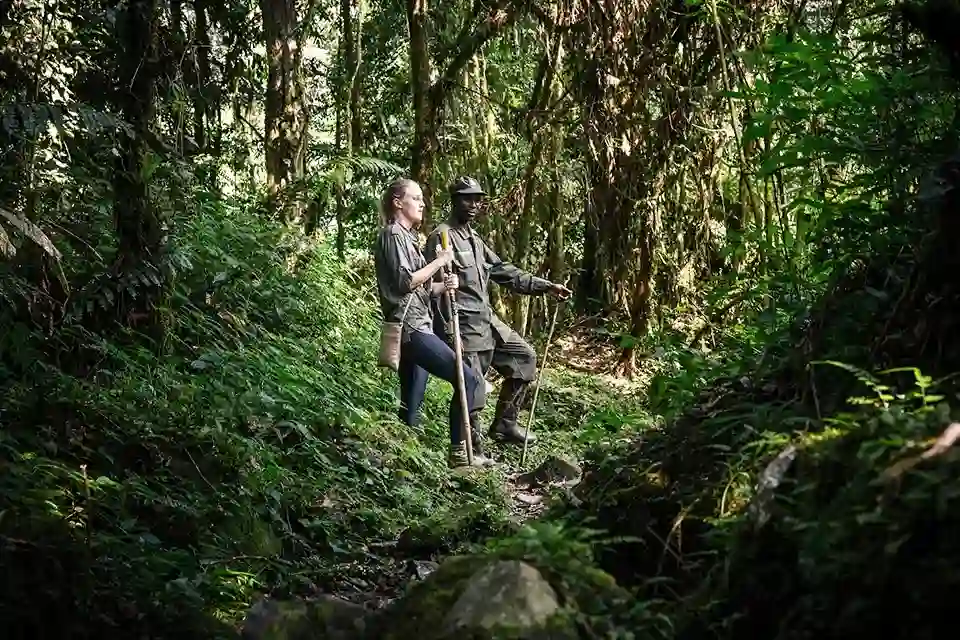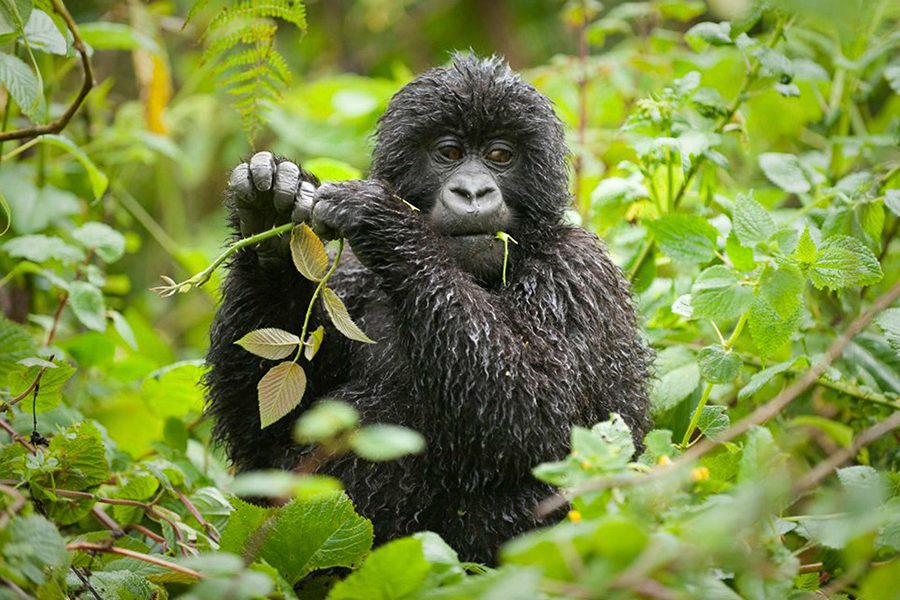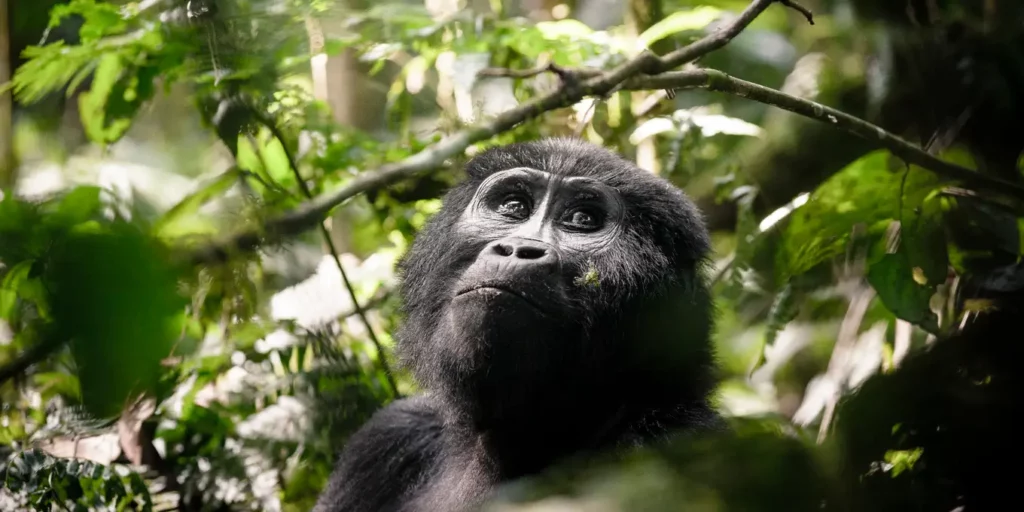Gorilla trekking in Bwindi Impenetrable Forest is undoubtedly the highlight of any Uganda safari. Spanning some 330 square kilometer, this misty mountainous rainforest jungle, a UNESCO World Heritage site, is nestled along the edge of the Great Rift Valley in southwestern Uganda. The park’s biggest attraction is the chance to track the endangered mountain gorillas. These gentle giants – the world’s largest primate, can weigh in at up to 200kg. But it’s not just mountain gorillas that call Bwindi home—this biodiverse haven also shelters various mammals, a wealth of rare, endemic bird species and three-horned chameleons .
On a gorilla trek in Bwindi Impenetrable Forest, you will hike through the dense rainforest, often bending and stooping as you move. Your adventure begins early in the morning, with trackers sent ahead to locate the mountain gorillas and relay their positions to the rangers. The length and distance of each trek vary daily, ranging from as little as 2 hours to up to 7 hours.
Accompanied by the expert rangers from the Ugandan Wildlife Authority, you’ll follow signs of the gorillas’ presence—such as droppings, bamboo stalks nibbled by the gorillas, and broken twigs—revealing that you’re drawing near. When you finally come face to face with these magnificent creatures, it’s a moment you’ll never forget. You’ll have one hour to observe and capture photographs of the gorilla family, making the most of this rare and incredible experience.

Bwindi is a fantastic destination year-round, with travelers mostly come to Uganda primarily for a gorilla trekking adventure. While sightings of the gorillas are nearly guaranteed throughout the year, the best trekking conditions are typically found during the dry season, from June to August and December to February. The wet season, on the other hand, can make the trails slippery and more challenging to navigate. Since gorilla trekking is a rare, once-in-a-lifetime experience, the thought of rain might be a concern. However, the expert guides are committed to ensuring your experience remains exceptional, regardless of the weather. If the rain is heavy, they may choose to wait until conditions improve before heading toward the gorillas.
Traveling to Bwindi Impenetrable National Park directly from Kampala or Entebbe International Airport typically takes around 8 to 9 hours by car, without accounting for stops along the way.
To save time, many travelers choose to book a flight to Kihihi (for Buhoma or Ruhija) or Kisoro (for Rushaga or Nkuringo) as a quicker route to the park. It’s also good to know that Bwindi Forest is much closer to Kigali, the capital of Rwanda, which is why many road trips to the park start there.
Alternatively, many visitors opt to include Bwindi in a longer road trip across Uganda. One popular route is from Kibale Forest or Queen Elizabeth NP, with the journey lasting anywhere from two to six hours depending on your starting point and which gorilla trekking center you’re heading to. Another option is to approach Bwindi from Lake Mburo, which takes five to seven hours by car.
The cost of a Bwindi gorilla trekking permit is currently US$800 for nonresidents. While this might seem pricey, it’s actually a great deal compared to the same activity in Rwanda, the only other safe country where you can see these creatures in the wild.
For foreign residents, the permit price drops to US$700, while East African citizens pay US$80, and holders of other African passports are charged US$500. Gorilla trekking is available in two Ugandan national parks: Bwindi Impenetrable National Park and Mgahinga Gorilla National Park. Both offer a similar experience, where you can spend one hour observing a gorilla group after locating them. Each group is limited to eight trekkers.
Bwindi also offers a one-of-a-kind experience known as the gorilla habituation. This unique activity allows a small group of four tourists to track two semi-habituated gorilla families, with the chance to stay for an impressive four hours. However, since these gorillas are still adjusting to human presence, they tend to keep their distance, making sightings a bit more challenging. The price for this exclusive experience is US$1,500.

During your gorilla trek in Bwindi, you’ll have the chance to spend one hour with the gorillas. The trek is typically done in the morning and can take anywhere from 1 hour to 6 hours to locate the gorillas. Once your group gets close, you’ll stop to leave some of your personal items with the trackers, who will remain behind.
From there, you’ll move in closer to the gorillas for the viewing. The guide will help ensure you have the best possible experience, positioning you for great photos and guiding you around the gorilla family so you can observe different members, including the dominant silverback.
Mountain gorillas are generally not aggressive and are often called “gentle giants.” Despite their immense size, they are not dangerous to be around, as their calm nature allows for close encounters on foot. Male gorillas may display aggression towards other males, particularly during dominance disputes, and these encounters can sometimes lead to fights.
While these confrontations usually result in one gorilla leaving the group or a split occurring, there are rare instances where a fight can be fatal. Occasionally, a gorilla might perform a mock charge towards tourists, but this is more of a display and has never caused injury. Before you set off on your trek, you’ll receive a thorough briefing on how to react if a gorilla approaches you or shows signs of aggression. As long as you follow your guide’s instructions, you should be completely safe.

Mountain Gorillas roam freely and don’t stick to established trails, so your guide will initially lead you along a forest path to get you within the general area of the gorilla family.
Once you’re close, you’ll likely need to leave the trail and follow the guide and trackers as they navigate through dense undergrowth. They’ll try to find the easiest path and will use machetes to clear branches as needed. Bwindi Impenetrable Forest lives up to its name, with thick vegetation that can make even the trails hard to navigate.
After rain, the paths can become slippery. To make your trek easier, it’s highly recommended to hire a porter, who will not only carry your bag but also offer a steady hand to help you along the trail. You can read our blog about the difficulty of gorilla trekking.
Gorillas roam freely within their territory, which can sometimes make locating them a challenge.
During the pre-trek briefing with the head ranger, you’ll be informed that sightings are not guaranteed. However, the success rate has been nearly 100% in recent years, so it’s highly likely that you’ll encounter the gorillas. The main reason some people don’t make it is if they are not physically prepared and decide to turn back.
That said, most people in reasonable physical condition will succeed. The guides and porters will go to great lengths to help you, with some even assisting by pulling and pushing trekkers up the mountain slopes. To improve your chances, be sure to come well-equipped with a walking stick, water, a rain jacket, and snacks. Good hiking shoes are also essential for the journey.
Bwindi offers a variety of great lodges and camps, both within and near the park. Some are located in nearby villages, while others are right on the edge of the national park.
Personally, I would recommend staying in the forest, as it gives you the chance to spot monkeys and other wildlife. If you’re booking your own accommodation, it’s essential to know which trekking hub you’ll be using—Buhoma, Ruhija, Rushaga, or Nkuringo.
These hubs are quite spread out, so it’s best to choose a lodge near the one you’ll be trekking from. This might seem like obvious advice, but I’ve often encountered travelers who have to drive to a different trailhead each morning, then return to their lodge afterward. While this is manageable (e.g., driving between Buhoma and Ruhija takes about two hours, or between Rushaga and Nkuringo takes about one hour), it’s not ideal.
Traveling between other combinations can be much more time-consuming—especially Buhoma and Nkuringo, which are six hours apart by car. Here are some of our recommended Bwindi lodges: